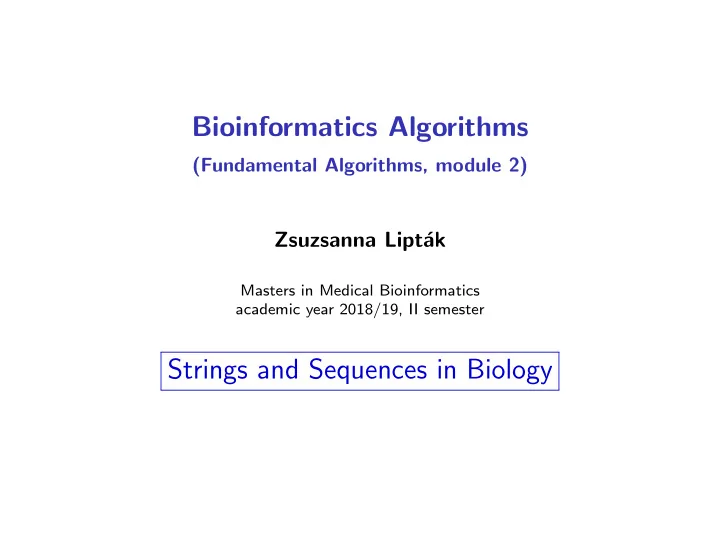

Bioinformatics Algorithms (Fundamental Algorithms, module 2) Zsuzsanna Lipt´ ak Masters in Medical Bioinformatics academic year 2018/19, II semester Strings and Sequences in Biology
Strings in molecular biology Strings are finite sequences over an alphabet Σ (also called sequences ). • DNA (characters: nucleotides) Σ = { A,C,G,T } • RNA (characters: nucleotides) Σ = { A,C,G,U } • proteins (characters: amino acids) Σ = { A,C,D,E,F,...,W,Y } • many other problems in molecular biology can be modelled by strings (e.g. gene order, SNPs, haplotypes, . . . ) 2 / 10
DNA: nucleotides 5’ ...AACAGTACCATGCTAGGTCAATCGA...3’ 3’ ...TTGTCATGGTACGATCCAGTTAGCT...5’ • 4 characters: A C G T : adenine, cytosine, guanine, thymine (bases, nucleotides) • orientation (read from 5’ to 3’ end) • length measured in bp (base pairs) • double stranded, the two strands are antiparallel • A - T and C - G complementary (Watson-Crick pairs) • reverse complement: ( ACCTG ) rc = CAGGT 3 / 10
The central dogma of molecular biology source: Wonderwikikids.com 4 / 10
DNA: nucleotides 5’ ...AACAGTACCATGCTAGGTCAATCGA...3’ 3’ ...TTGTCATGGTACGATCCAGTTAGCT...5’ • during transcription, one strand is copied into mRNA (messenger RNA), except all T’s are replaced by U’s • the strand which is identical to the mRNA is called coding strand • the other strand (the one which is used for the transcription) is called template strand • Both strands can be used as coding strands (for different genes). • Some DNA strings are circular: bacterial DNA, mitochondrial DNA. 5 / 10
RNA: nucleotides • like DNA, except: • 4 characters: A C U G : adenine, cytosine, uracil, guanine (U instead of T) • RNA is single-stranded • builds double stranded hybrids with DNA • RNA folds upon itself (makes complex 3-dim structures), using the Watson-Crick pairs and other bonds (RNA folding) 6 / 10
Protein: Amino acids There are 20 common amino acids (aa’s); two systems of abbreviations are used: 3-letter-code and 1-letter-code. We usually use the 1-letter-code. alanine Ala A leucine Leu L arginine Arg R lysine Lys K asparagine Asn N methionine Met M aspartic acid Asp D phenylalanine Phe F cysteine Cys C proline Pro P glutamine Gln Q serine Ser S glutamic acid Glu E threonine Thr T glycine Gly G tryptophan Trp W histidine His H tyrosine Tyr Y isoleucine Ile I valine Val V 7 / 10
The genetic code source: Wikimedia commons 8 / 10
The genetic code • standard genetic code (some organisms use a different one) • 3 different reading frames for translation: The DNA sequence 5’ ...TATTCGAATCGGC...3’ can be translated in 3 different ways, leading to different aa sequences. • degeneracy of the genetic code • silent mutations 9 / 10
The genetic code • standard genetic code (some organisms use a different one) • 3 different reading frames for translation: The DNA sequence 5’ ...TATTCGAATCGGC...3’ can be translated in 3 different ways, leading to different aa sequences. • degeneracy of the genetic code : 64 codons but only 20 aa’s plus stop codon • silent mutations 9 / 10
The genetic code • standard genetic code (some organisms use a different one) • 3 different reading frames for translation: The DNA sequence 5’ ...TATTCGAATCGGC...3’ can be translated in 3 different ways, leading to different aa sequences. • degeneracy of the genetic code : 64 codons but only 20 aa’s plus stop codon • silent mutations : if third position mutates, this often does not alter the aa 9 / 10
The genetic code Exercise: Translate this DNA sequence according to the 3 different reading frames: 5’ ...TATTCGAATCGGC...3’ 10 / 10
The genetic code Exercise: Translate this DNA sequence according to the 3 different reading frames: 5’ ...TATTCGAATCGGC...3’ Solution • 1st reading frame: TAT , TCG , AAT , CGG , C = Tyr-Ser-Asn-Arg = YSNR • 2nd reading frame: T , ATT , CGA , ATC , GGC = Ile-Arg-Ile-Gly = IRIG • 3rd reading frame: TA , TTC , GAA , TCG , GC = Phe-Glu-Ser = FES 10 / 10
Recommend
More recommend